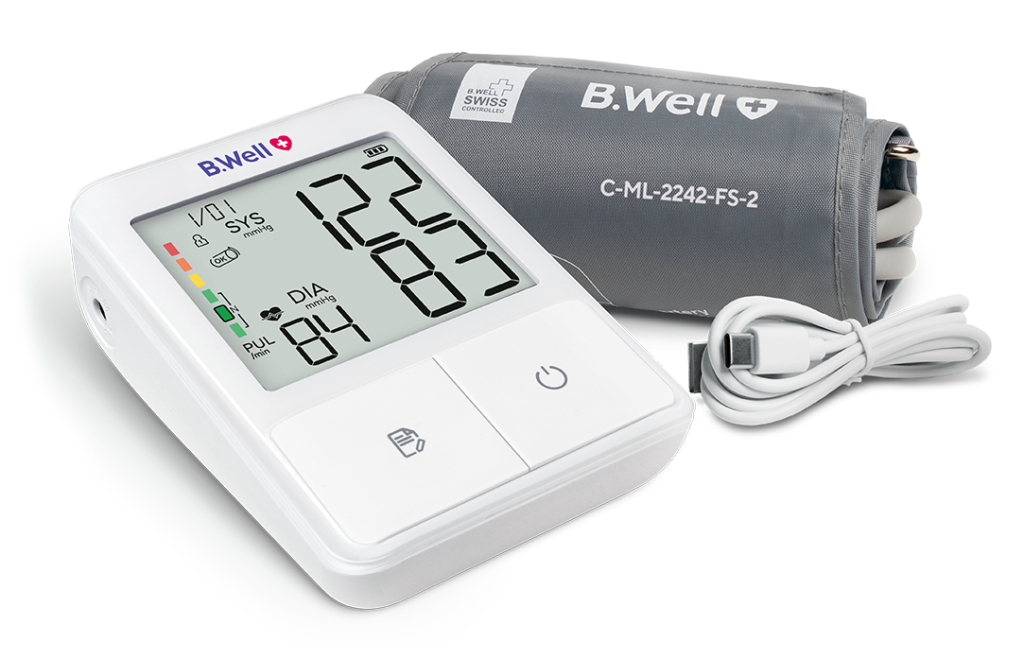Hypertension, or hypertension, is one of the most common diseases of the cardiovascular system. But, unfortunately, quite often the initial symptoms of hypertension are absent or go unnoticed, that is why the disease is called a ‘silent killer’. According to the European recommendations of 2024, pressure values of less than 120/70 mmHg are considered normal. A reading above 140/90 mmHg when measured by a doctor or above 135/85 mmHg when measured at home is considered hypertension. The higher the BP values, the higher the risk of developing complications that can threaten life and health.
Uncontrolled high blood pressure affects blood vessels and target organs: heart, blood vessels, brain, kidneys and eyes. In this article we will tell you about the most common complications of arterial hypertension and how to avoid them.
Hypertrophy of the left ventricle
When the heart is exposed to high blood pressure for long periods of time, it is forced to work with an increased workload. This results in thickening of the walls of the left ventricle, which is called left ventricular hypertrophy. This process can be compared to the ‘recycling’ of the heart muscle: it is replaced by fibrous tissue, becoming more dense and rigid, which makes it more difficult to contract.
In the early stages of hypertrophy can be asymptomatic, but over time the pathology leads to a decrease in the ability of the heart to pump blood effectively. Thickened walls do not allow the left ventricle to relax normally between contractions, which leads to blood stasis and impaired blood supply to organs. This increases the risk of even more serious cardiovascular disease.
Heart failure
This is a condition in which the heart is unable to provide sufficient blood flow to meet the body's needs for oxygen and nutrients. Against the background of hypertension, the heart is forced to work at the limit of its capabilities, which gradually leads to its exhaustion. Increased load on the heart muscle causes its weakening, and as a result, the normal pumping function is disturbed.
Over time, heart failure leads to fluid stagnation in the lungs, legs and other parts of the body, causing oedema. Patients often experience shortness of breath, especially with physical exertion, as well as a feeling of fatigue even when they are not visibly active.
Ischaemic stroke
Occurs when the blood supply to an area of the brain stops due to narrowing or blockage of a blood vessel. High blood pressure accelerates the development of atherosclerosis - the formation of plaques on the walls of arteries. These plaques can block a vessel, which interferes with normal blood flow. As a consequence, part of the brain does not receive nutrition, which leads to cell death.
The main symptom of an ischaemic stroke is sudden weakness or paralysis, loss of sensation in one side of the body, and problems with speech and coordination. It is important to note that a stroke requires emergency medical attention, as brain cell death can be irreversible.
Haemorrhagic stroke
Occurs when high blood pressure destroys the walls of blood vessels, leading to haemorrhage in the brain. With hypertension, blood vessels become fragile and any sudden increase in pressure, such as in a hypertensive crisis, can trigger their rupture. This results in damage to brain tissue.
Most often haemorrhagic stroke is manifested by severe headache, vomiting, loss of consciousness and paralysis. This type of stroke is extremely dangerous, as in the later stages, brain haemorrhage increases the risk of complications in the form of neurological sequelae requiring intensive rehabilitation.
Coronary heart disease (CHD)
Develops when the blood vessels that supply oxygen to the heart become narrowed. This is due to the long-term negative effects of hypertension on the heart and blood vessels, namely the formation of atherosclerotic plaques. As a result, the heart experiences oxygen deficiency, which leads to chest pain and even myocardial infarction.
The main symptom of IBS is pain behind the sternum, which increases with exercise or stress. If the disease progresses, myocardial infarction may develop.
Atrial fibrillation
Prolonged hypertension leads to dilation and/or fibrosis of the left atrium. provoking the development of atrial fibrillation (atrial fibrillation). This is a condition in which the heart contracts with an irregular rhythm. Untimely diagnosis of hypertension increases the load on the heart muscle, which leads to a violation of the normal conduction of nerve impulses. This causes irregular atrial contractions, increasing the likelihood of blood clots.
The danger of atrial fibrillation is that it increases the risk of stroke. Blood clots that form in the atria can enter the bloodstream and block the brachiocephalic vessels. When this happens, symptoms of arrhythmia may include a fast or irregular heartbeat, weakness, dizziness and chest pain.

Chronic kidney disease (CKD)
Kidney damage begins with microscopic changes in the capillaries, which over time lead to sclerosis and impaired blood filtration. Kidney damage on the background of hypertension is often asymptomatic in the early stages, but over time, oedema appears, creatinine levels rise and urination becomes impaired. If hypertension and CKD are not treated in a timely manner, acute renal failure develops, requiring intensive care and, in some cases, dialysis.
Prevention of complications of hypertension
Even small fluctuations in pressure in the upward direction can significantly increase the load on the heart and blood vessels, which can further lead to the development of dangerous complications. Therefore, it is extremely important to know how to keep the indicators normal.
The following guidelines will help you to cope with this task:
Weight control. Maintaining a normal body weight will help to reduce the load on the heart and blood vessels and normalize blood pressure.
Proper nutrition. A balanced diet rich in vegetables, fruits and low salt content helps to reduce blood pressure and maintain vascular health.
Physical activity. Regular moderate physical activity (e.g., walking outdoors, swimming, strength training) can help strengthen your heart, improve blood circulation, and lower your blood pressure.
Quitting smoking and alcohol. These bad habits trigger hypertension and increase the risk of other cardiovascular diseases.
Stress control. Chronic stress and anxiety are strong factors in the development of cardiovascular disease.
Medication management. If hypertension has already been diagnosed, it is important to adhere to the doctor's recommendations and take prescribed medications regularly.
Blood pressure control is an essential part of preventing complications of hypertension. The B.Well MED-50 automatic BPM will help you to fulfil this task. Its unique features:

Arm shake indicator gives you double control and accurate results
Memory for 100 measurements allows you to track the dynamics of pressure changes and keep an electronic diary.
The anatomical cuff fits the shape of the hand, providing comfort during measurement and accurate readings.
Arrhythmia indicator warns of possible heart rhythm disturbances.
The color pressure scale on the display makes it easy to interpret the results.
USB-C cord makes it convenient and always at hand
Maintaining normal blood pressure is the key to a long and healthy life. The B.Well MED-50 BPM will help you react in time to changes and ensure your health for years to come.
 Global - English
Global - English 
 Germany
Germany
 Albania
Albania
 France
France
 Bosnia and Herzegovina
Bosnia and Herzegovina
 Austria
Austria
 Bulgaria
Bulgaria
 Switzerland
Switzerland
 Croatia
Croatia
 Cyprus
Cyprus
 Denmark
Denmark
 Estonia
Estonia
 Finland
Finland
 Greece
Greece
 Hungary
Hungary
 Kosovo
Kosovo
 Latvia
Latvia
 Lithuania
Lithuania
 Macedonia
Macedonia
 Malta
Malta
 Moldova
Moldova
 Montenegro
Montenegro
 Norway
Norway
 Poland
Poland
 Romania
Romania
 Russia
Russia
 Serbia
Serbia
 Slovenia
Slovenia
 Slowakia
Slowakia
 Spain
Spain
 Sweden
Sweden
 Ukraine
Ukraine
 Armenia
Armenia
 Azerbaijan
Azerbaijan
 Georgia
Georgia
 Jordan
Jordan
 Kazakhstan
Kazakhstan
 Kuwait
Kuwait
 Lebanon
Lebanon
 Malaysia
Malaysia
 Mongolia
Mongolia
 Oman
Oman
 Pakistan
Pakistan
 Saudi Arabia
Saudi Arabia
 Sri Lanka
Sri Lanka
 United Arab Emirates
United Arab Emirates
 Uzbekistan
Uzbekistan
 Vietnam
Vietnam
 Azerbaijan
Azerbaijan
 Georgia
Georgia
 Bolivia
Bolivia
 Colombia
Colombia
 Algeria (Arabic)
Algeria (Arabic)
 Algeria (French)
Algeria (French)
 Egypt
Egypt
 Mauritius
Mauritius
 Morocco
Morocco
 Nigeria
Nigeria
 Republic of South Africa
Republic of South Africa
 International
International


